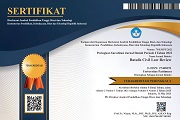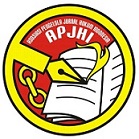Copyright Protection for Songs Uploaded to the Spotify Digital Music Application Without Permission
 )
)
(1) Faculty of Law, Universitas Pattimura, Ambon, Indonesia
(2) Faculty of Law, Universitas Pattimura, Ambon, Indonesia
(3) Faculty of Law, Universitas Pattimura, Ambon, Indonesia

 Corresponding Author
Corresponding Author
Abstract
Introduction: Copyright holders can and have the right to determine who can use their work or not.However,Uploading songs by Spotify application users can unknowingly trigger copyright infringement.
Purposes of the Research: To examine the legal relationship between the Spotify application and copyright holders and the form of copyright protection for songs uploaded on the Spotify application without permission.
Methods of the Research: The research method used in this writing is the normative legal research method with a legislative approach, case approach and conceptual approach.
Results of the Research: The legal relationship between the Spotify Music application and the Copyright Holder is based on a license agreement made in the form of an authentic deed and the form of legal protection of the creator's rights against uploading songs on the Spotify Music application without permission can be protected preventively and repressively. However, the most effective form of legal protection to be applied to this problem is the form of repressive legal protection.
Keywords
DOI
10.47268/ballrev.v5i3.2805
Published
2024-11-29
How To Cite
@article{BALLREV2805,
author = {Maichel Lesnussa and Theresia Narwadan and Muchtar Labetubun},
title = {Copyright Protection for Songs Uploaded to the Spotify Digital Music Application Without Permission},
journal = {Batulis Civil Law Review},
volume = {5},
number = {3},
year = {2024},
keywords = {Legal Protection; Creator's Rights; Spotify.},
abstract = {Introduction: Copyright holders can and have the right to determine who can use their work or not.However,Uploading songs by Spotify application users can unknowingly trigger copyright infringement.Purposes of the Research: To examine the legal relationship between the Spotify application and copyright holders and the form of copyright protection for songs uploaded on the Spotify application without permission.Methods of the Research: The research method used in this writing is the normative legal research method with a legislative approach, case approach and conceptual approach.Results of the Research: The legal relationship between the Spotify Music application and the Copyright Holder is based on a license agreement made in the form of an authentic deed and the form of legal protection of the creator's rights against uploading songs on the Spotify Music application without permission can be protected preventively and repressively. However, the most effective form of legal protection to be applied to this problem is the form of repressive legal protection.},
issn = {2746-8151}, pages = {189--195} doi = {10.47268/ballrev.v5i3.2805},
url = {https://fhukum.unpatti.ac.id/jurnal/ballrev/article/view/2805}
}
Journal Article
Dewi, Rachmayani. “Perjanjian Lisensi Hak Cipta Atas Lagu Antara Pencipta Lagu Dengan Produser Rekaman Untuk Melindungi Hak Ekonomi Para Pihak.” Syiar Hukum: Jurnal Ilmu Hukum 16, no. 2 (2018): 182–206. https://doi.org/10.29313/sh.v16i2.4883.
Labetubun, Muchtar A H, and Sabri Fataruba. “Peralihan Hak Cipta Kepada Ahli Waris Menurut Hukum Perdata.” SASI 22, no. 2 (2016): 1–11. https://fhukum.unpatti.ac.id/jurnal/sasi/article/view/163.
Netti, S. Yollis Michdon, and Irwansyah. “Spotify: Aplikasi Music Streaming Untuk Generasi Milenial.” Jurnal Komunikasi 10, no. 1 (2018): 1–16.
Book
Fahmi, Khairil. “Aspek Komersialisasi Kekayaan Intelektual Dalam Hukum Perikatan.” Jurnal Hukum Al-Hikmah: Media Komunikasi Dan Informasi Hukum Dan Masyarakat 2, no. 3 (2021): 428–46.
Ibrahim, Johnny. Teori Dan Metode Penelitian Hukum Normatif. Malang: Bayu Media Publishing, 2006.
Saidin, OK. Aspek Hukum Hak Kekayaan Intelektual. Jakarta: Rajagrafindo Persada, 2015.
Soeroso, R. Pengantar Ilmu Hukum. Jakarta: Sinar Grafika, 2015.
Thesis, Online/World Wide Web and Others
Leu, Patrick. “Number of Spotify Premium Subscribers Worldwide from 1st Quarter 2015 to 3rd Quarter of 2024.” www.statista.com, 2024. https://www.statista.com/statistics/244995/number-of-paying-spotify-subscribers/.
Netrilis.com. “Netrilis Music Distribution Agreement.” www.netrilis.com, 2024. https://www.netrilis.com/p/netrilis-music-distribution-agreement.html.| Dublin Core | PKP Metadata Items | Metadata for this Document | |
| 1. | Title | Title of document | Copyright Protection for Songs Uploaded to the Spotify Digital Music Application Without Permission |
| 2. | Creator | Author's name, affiliation, country | Maichel Lesnussa; Faculty of Law, Universitas Pattimura, Ambon; Indonesia |
| 2. | Creator | Author's name, affiliation, country | Theresia Nolda Agnes Narwadan; Faculty of Law, Universitas Pattimura, Ambon; Indonesia |
| 2. | Creator | Author's name, affiliation, country |
Muchtar Anshary Hamid Labetubun; Faculty of Law, Universitas Pattimura, Ambon; Indonesia  |
| 3. | Subject | Discipline(s) | |
| 3. | Subject | Keyword(s) | Legal Protection; Creator's Rights; Spotify. |
| 4. | Description | Abstract | Introduction: Copyright holders can and have the right to determine who can use their work or not.However,Uploading songs by Spotify application users can unknowingly trigger copyright infringement.Purposes of the Research: To examine the legal relationship between the Spotify application and copyright holders and the form of copyright protection for songs uploaded on the Spotify application without permission.Methods of the Research: The research method used in this writing is the normative legal research method with a legislative approach, case approach and conceptual approach.Results of the Research: The legal relationship between the Spotify Music application and the Copyright Holder is based on a license agreement made in the form of an authentic deed and the form of legal protection of the creator's rights against uploading songs on the Spotify Music application without permission can be protected preventively and repressively. However, the most effective form of legal protection to be applied to this problem is the form of repressive legal protection. |
| 5. | Publisher | Organizing agency, location | Faculty of Law, Universitas Pattimura |
| 6. | Contributor | Sponsor(s) | |
| 7. | Date | (YYYY-MM-DD) | 2024-11-29 |
| 8. | Type | Status & genre | Peer-reviewed Article |
| 8. | Type | Type | |
| 9. | Format | File format | |
| 10. | Identifier | Uniform Resource Identifier | https://fhukum.unpatti.ac.id/jurnal/ballrev/article/view/2805 |
| 10. | Identifier | Digital Object Identifier | 10.47268/ballrev.v5i3.2805 |
| 11. | Source | Title; vol., no. (year) | Batulis Civil Law Review; Vol 5, No 3 (2024): VOLUME 5 ISSUE 3, NOVEMBER 2024 |
| 12. | Language | English=en | en |
| 13. | Relation | Supp. Files | |
| 14. | Coverage | Geo-spatial location, chronological period, research sample (gender, age, etc.) | |
| 15. | Rights | Copyright and permissions | Copyright: Authors who publish their manuscripts in this Journal agree to the following conditions: 1. The copyright in each article belongs to the author, as well as the right to patent. 2. Authors are able to enter into separate, additional contractual arrangements for the non-exclusive distribution of the journal's published version of the work (e.g., post it to an institutional repository or publish it in a book), with an acknowledgment of its initial publication in this journal. 3. Authors are permitted and encouraged to post their work online (e.g., in institutional repositories or on their website) prior to and during the submission process, as it can lead to productive exchanges, as well as earlier and greater citation of published work. 4. Authors have the right to self-archiving of the article (Author Self-Archiving Policy)
Licence : Batulis Civil Law Review Journal is disseminated based on the Creative Commons Attribution-NonCommercial 4.0 International license terms. This license allows anyone to copy and redistribute this material in any form or format, compose, modify, and make derivatives of this material for any purpose. You cannot use this material for commercial purposes. You must specify an appropriate name, include a link to the license, and certify that any changes have been made. You can do this in a way that is appropriate, but does not imply that the licensor supports you or your use.
|
Copyright (c) 2024 Maichel Lesnussa, Theresia Nolda Agnes Narwadan, Muchtar Anshary Hamid Labetubun
License URL: https://creativecommons.org/licenses/by-nc/4.0

 : 1706 times
: 1706 times Download : 771 times
Download : 771 times















